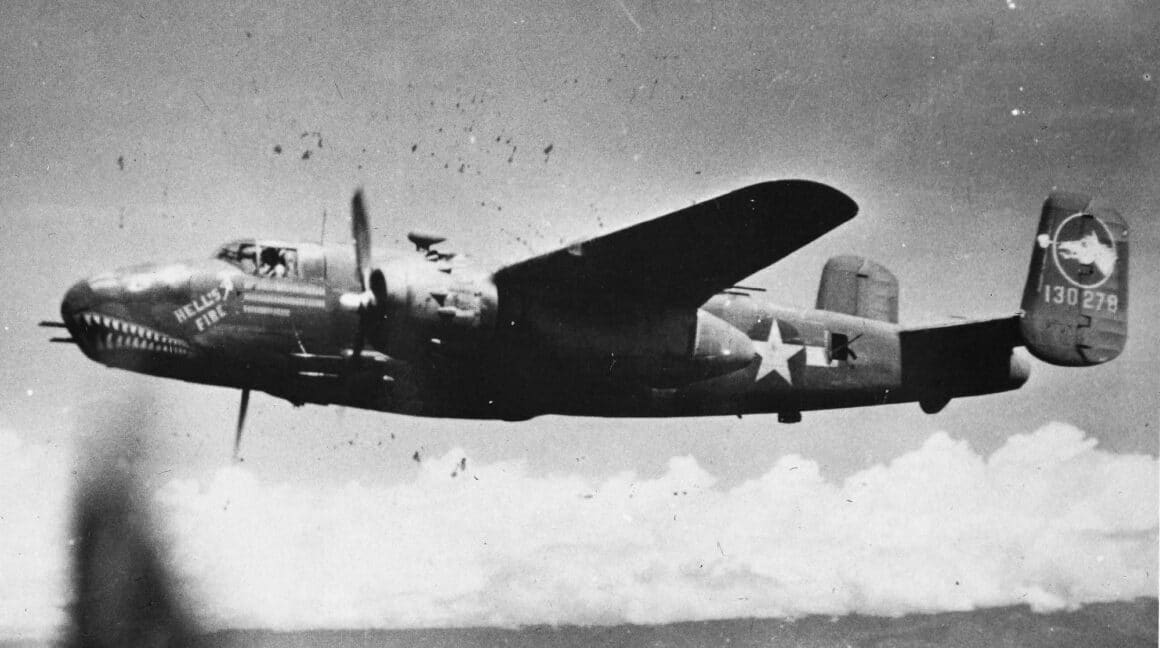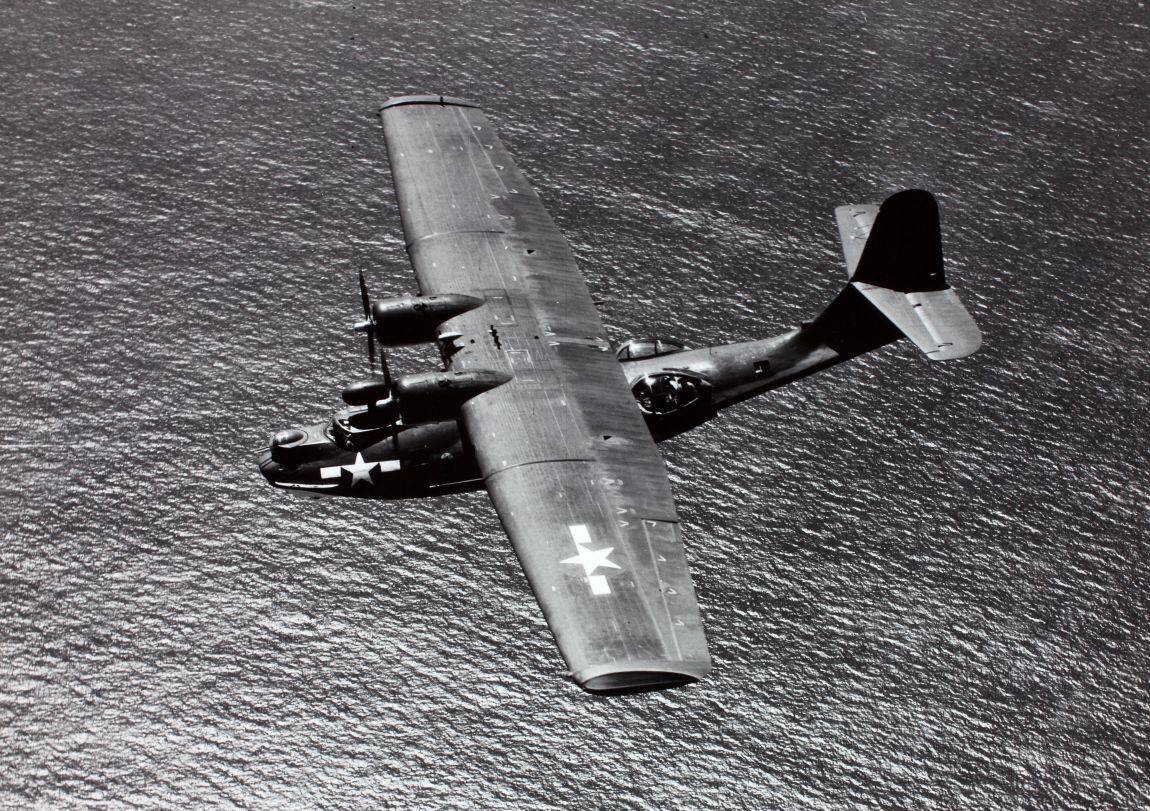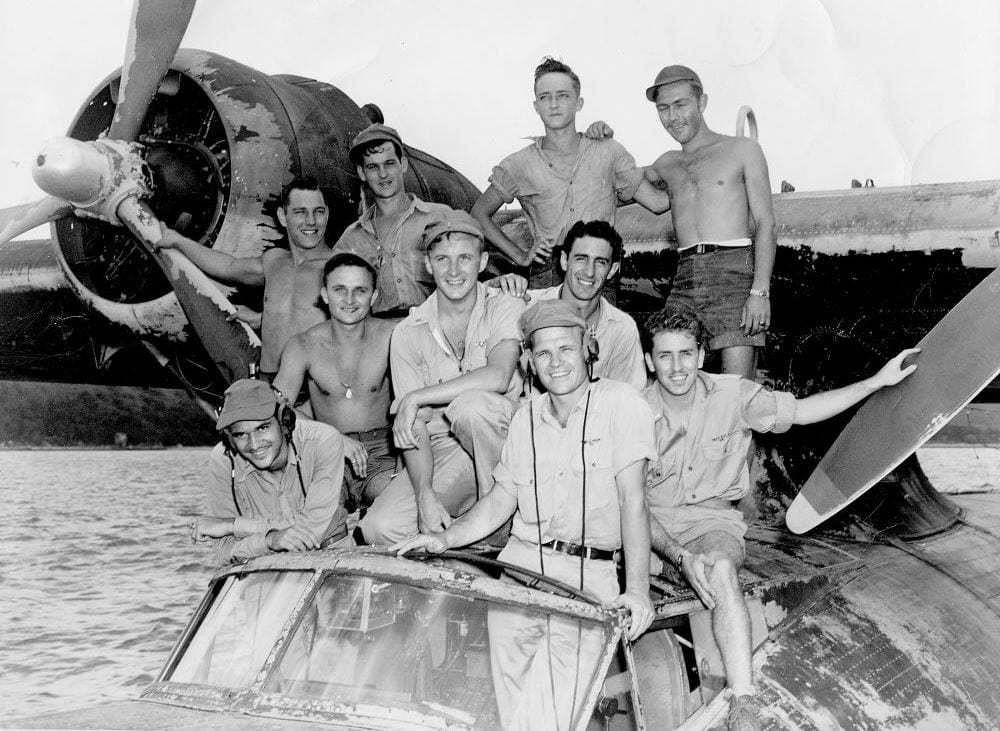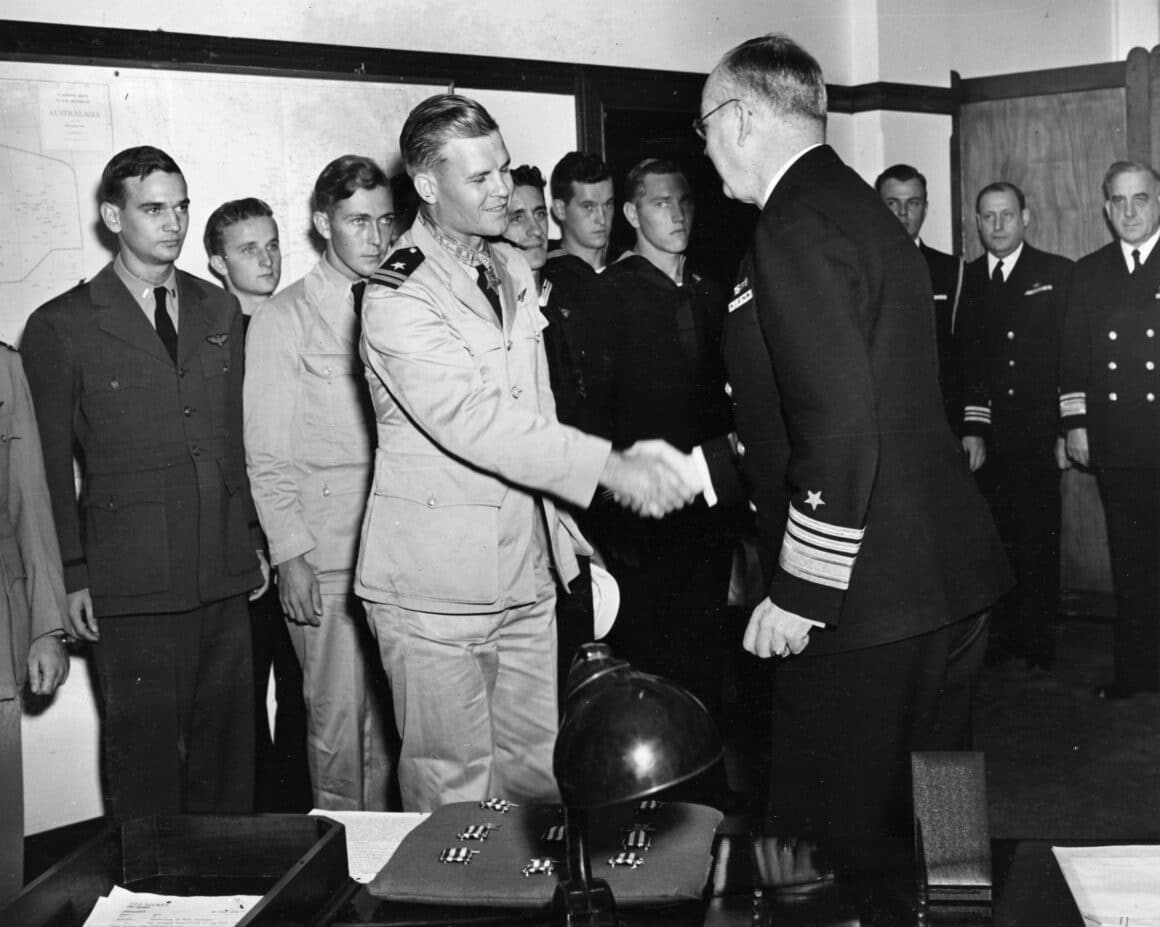Six for Six
That next business for Gordon and crew was the crew of B-25D Mitchell SN 41-30041 named Gremlin’s Holiday assigned to the 498th BS of the 345th BG and piloted by 1st LT Edgar R. Cavin. The B-25 strafer had ditched about four miles northwest of Kavieng and only 400 yards offshore. After executing another power stall landing Gordon put the Black Cat on the water. All six of Cavin’s crew were in the water. The swells were so high (up to 18 feet) that Gordon had to shut down the port engine. While under heavy fire from the Japanese on the island, but partially concealed when in the troughs between the heavy swells, Gordon’s crew hauled all six of Cavin’s crew aboard Gardenia Six through the port side waist blister. After restarting the port engine, Gordon got the leaky flying boat airborne and set course for Samarai. Score: Six survivors plus Gordon’s own crew of nine = 15 aboard the aircraft. Bucket brigade urgency rising. By this point two of the P-47D escorts were forced to return to base when they ran low on fuel.

Going Back for More
After putting about 20 miles between them and the Japanese, Gordon and crew were notified that yet another bomber was down in the water. This time it was B-25D Mitchell SN 41-30370 named Pissonit assigned to the 71st BS of the 38th BG and piloted by 1st LT Eugene E. Benson. The aircraft had ditched about two and a half miles from North Cape near Kavieng about a mile offshore. Gordon power-stalled the PBY-5 to put it in the water again, shut down the port engine, and his crew pulled three survivors from the ditched B-25’s crew of six aboard the Black Cat- again via the port side waist blister. After restarting the port engine and getting the increasingly heavy Catalina into the air, Arkansas Traveler again set course for Samarai Island. Score: Nine survivors plus Gordon’s own crew of nine = 18 aboard the aircraft. Bucket brigade working overtime. The other two escorting P-47s were forced to return to base when they too ran low on fuel.

Against All Odds
Gordon and crew were alerted that still another strafer had ditched in the water. This was B-25D Mitchell SN 41-30521 assigned to the 500th BS of the 345th BG and piloted by CAPT William J. Cavoli. Cavoli, who was the Operations Officer for the 500th BS, had ditched only about 600 yards from shore- close enough that the now unescorted Gordon was forced to overfly Kavieng itself while on approach to his next (and last) power-stall landing- a risky proposition indeed. Once again the PBY-5 fairly dropped out of the sky between the huge swells and immediately began taking on water. But after shutting down that port engine and taxying over to Cavoli and his crew, Arkansas Traveler was able to pull all six survivors aboard the Black Cat through the waist blister. Once again those heavy swells helped hide the flying boat in the troughs from the Japanese gunners on the island, who were well within range and threw everything they had at Gardenia Six. Gordon coaxed the now severely overloaded PBY-5 into the air and headed toward friendly territory. Score: 15 survivors plus Gordon’s own crew of nine = 24 aboard the aircraft. Bucket brigade finally catches up.

The Aftermath
Because several of the survivors aboard the Arkansas Traveler were wounded or injured, Gordon decided to fly to Langemak Bay near Finschafen to drop the survivors off there. Gordon’s crew administered first aid in the crowded aircraft during the flight to Finschafen. After getting the wounded survivors aboard the seaplane tender USS San Pablo (AVP-30) and the rest of them squared away, Arkansas Traveler returned to Samarai Island. After the Kavieng mission Gordon and his crew continued flying PBY 71 on daily missions for the next seven months. Gordon and crew had no idea they had been recommended for any kind of special recognition for their Dumbo exploits at Kavieng. Gordon was promoted to Lieutenant though.

Awards and Recognition
In September of 1944, Gordon and his crew were flown to Brisbane, Australia. There, Vice Admiral Thomas C. Kinkaid awarded the Congressional Medal of Honor to LT Nathan G Gordon USNR and presented his entire crew with the Silver Star. Years later Gordon would say that a telegram from Admiral William F. “Bull” Halsey, mentioning his Kavieng Dumbo mission, would be one of his proudest memories. The telegram read, “Please pass my admiration on to that saga-writing Kavieng Cat crew. This rescue was truly one of the most remarkable feats of the war – Halsey”. Gordon went on to become an instructor pilot at NAS Jacksonville and was flying out of NAS Anacostia in Washington DC when the war ended.

Business and Politics
After his discharge from Naval service in 1945, Gordon returned to Arkansas and started up a law practice in his home town with his brother Edward Gordon, Jr. It didn’t take long before Gordon entered politics. He was elected Lieutenant Governor of Arkansas in 1946 and held the job for 21 years, leaving office in 1967 as the longest-serving Lieutenant Governor in the history of the state. The Arkansas Aviation Historical Society selected Gordon in 1980 as one of five initial inductees to the Arkansas Aviation Hall of Fame. Gordon attended Medal of Honor reunions for many years and formed a lasting friendship with Bill Cavoli- one of the men he and his crew pulled from nearly certain death at Kavieng in 1944. Nathan Green Gordon passed away on 9 September 2008 at the age of 92 at Arkansas Medical Services Center in Little Rock, AR. He is buried at Elmwood Cemetery in Morrilton, AR.

Medal of Honor Citation
“For extraordinary heroism above and beyond the call of duty as commander of a Catalina patrol plane in rescuing personnel of the U.S. Army 5th Air Force shot down in combat over Kavieng Harbor in the Bismarck Sea, 15 February 1944. On air alert in the vicinity of Vitu Islands, Lt. (then Lt. j.g.) Gordon unhesitatingly responded to a report of the crash and flew boldly into the harbor, defying close-range fire from enemy shore guns to make 3 separate landings in full view of the Japanese and pick up 9 men, several of them injured. With his cumbersome flying boat dangerously overloaded, he made a brilliant takeoff despite heavy swells and almost total absence of wind and set a course for base, only to receive the report of another group stranded in a rubber life raft 600 yards from the enemy shore. Promptly turning back, he again risked his life to set his plane down under direct fire of the heaviest defenses of Kavieng and take aboard 6 more survivors, coolly making his fourth dexterous takeoff with 15 rescued officers and men. By his exceptional daring, personal valor, and incomparable airmanship under most perilous conditions, Lt. Gordon prevented certain death or capture of our airmen by the Japanese.”

